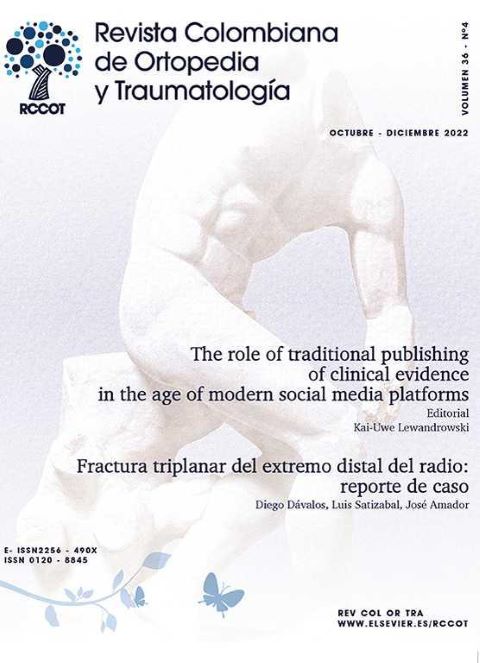Possible risk factors for open reduction in diaphyseal fractures of the forearm in children treated with intramedullary elastic nails
DOI:
https://doi.org/10.1016/j.rccot.2022.10.002Keywords:
forearm, diaphyses, bone fractures, radius, ulnaAbstract
Introduction: Diaphyseal fractures of the forearm are common injuries in the pediatric population and can be treated nonoperative. However, there are specific indications for intramedullary fixation with elastic nails with or without open reduction. The objective was to find predictive risk factors for closed reduction failure in children between 5 and 16 years old.
Material and methods: Descriptive observational retrospective study, case series type. The database of the pediatric orthopedics of a children’s hospital was reviewed from January 2017 to December 2021. Data from medical records and pre-operative radiographs were collected to analyze the possible variables related to closed reduction failure.
Results: A sample of 51 patients were analyzed, the average age was 10.68 years (±2.62), with a prevalence of males (82.35%). Twenty-two patients (43.14%) underwent open reduction, 20 (39.22%) closed, and 9 (17.65%) mixed. None of the variables were statistically significant. However, the angulation of the radius in the lateral X-ray showed a value of p = 0.07, which approached statistical significance and could be related to failure in closed reduction.
Conclusion: The findings of this paper can help surgeons to make the decision for open reduction, avoiding risks due to excessive manipulation of soft tissues such as compartment syndrome. A study with a larger sample is needed to increase the statistical power to validate predictive risk factors for failure in closed reduction in the management of diaphyseal fractures of the forearm.
Level of evidence: IV.
Downloads
References
Ploegmakers JJ, Verheyen CC. Acceptance of angulation in the non-operative treatment of paediatric forearm fractures. J Pediatr Orthop B. 2006;15:428-32. https://doi.org/10.1097/01.bpb.0000210594.81393.fe
Jeroense KT, America T, Witbreuk MM, van der Sluijs JA. Malunion of distal radius fractures in children. Acta Orthop. 2015;86:233-7. https://doi.org/10.3109/17453674.2014.981781
Madhuri V, Dutt V, Gahukamble AD, Tharyan P. Conservative interventions for treating diaphyseal fractures of the forearm bones in children. Cochrane Database Syst Rev. 2013;4:CD008775. https://doi.org/10.1002/14651858.CD008775.pub2
Zionts LE, Zalavras CG, Gerhardt MB. Closed treatment of displaced diaphyseal both-bone forearm fractures in older children and adolescents. J Pediatr Orthop. 2005;25: 507-12. https://doi.org/10.1097/01.bpo.0000158005.53671.c4
Antabak A, Luetic T, Ivo S, Karlo R, Cavar S, Bogovic M, et al. Treatment outcomes of both-bone diaphyseal paediatric forearm fractures. Injury. 2013;44 Suppl 3: S11-5. https://doi.org/10.1016/S0020-1383(13)70190-6
Blackman AJ, Wall LB, Keeler KA, Schoenecker PL, Luhmann SJ, O'Donnell JC, et al. Acute compartment syndrome after intramedullary nailing of isolated radius and ulna fractures in children. J Pediatr Orthop. 2014;34:50-4. https://doi.org/10.1097/BPO.0b013e31829527de
Makki D, Matar HE, Webb M, Wright DM, James LA, Ricketts DM. Elastic stable intramedullary nailing in paediatric forearm fractures: the rate of open reduction and complications. J Pediatr Orthop B. 2017;26:412-6. https://doi.org/10.1097/BPB.0000000000000408
Flynn JM, Jones KJ, Garner MR, Goebel J. Eleven years experience in the operative management of pediatric forearm fractures. J Pediatr Orthop. 2010;30:313-9. https://doi.org/10.1097/BPO.0b013e3181d98f2c
Larsen AV, Mundbjerg E, Lauritsen JM, Faergemann C. Development of the annual incidence rate of fracture in children 1980-2018: a population-based study of 32,375 fractures. Acta Orthop. 2020;91:593-7. https://doi.org/10.1080/17453674.2020.1772555
Mahecha-Toro M, Vergara-Amador E, González Ramírez M. Forearm diaphyseal fractures in children: intramedullary Kirschner's wire fixation treatment. Rev Esp Cir Ortop Traumatol (Engl Ed). 2018;62:71-9. https://doi.org/10.1016/j.recote.2017.12.002
Andrew HESE, Kevin S, Sachin A, Mary R, Scott R, et al. Risk Factors for Open Reduction in Operatively Treated Pediatric Both-Bone Forearm Fractures. The Orthopaedic Journal at Harvard Medical School: The Orthopaedic Journal at Harvard Medical School;. 2017:14-9.
Tay LHGM, Tan WXT, Lee NKL, Chew EM, Mahadev A, Wong KPL. Retrospective analysis: risk factors predicting failure of closed reduction in pediatric diaphyseal forearm fractures treated with elastic stable intramedullary nails (ESINs). J Pediatr Orthop B. 2022. https://doi.org/10.1097/BPB.0000000000000953
Downloads
Published
How to Cite
Issue
Section
License
Copyright (c) 2023 Revista Colombiana de ortopedia y traumatología

This work is licensed under a Creative Commons Attribution 3.0 Unported License.




